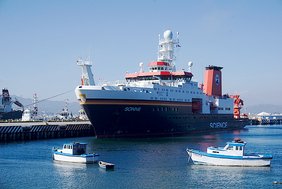The aim of the campaign is to investigate how processes on the scale of convective storms, and their interaction with the ocean, influence the inter-tropical convergence zone (ITCZ) in the Atlantic. Current research shows that these processes play a central role in the mesoscale dynamics and thus in the large-scale structure of the ITCZ. To understand the effects of convective storms on the properties of the ITCZ, the RV SONNE is crossing the ITCZ and the researchers are measuring it along the way. The cruise route allows vertical profiles of the atmosphere and ocean to be linked with long-term buoy measurements from the PIRATA network. The PIRATA network (Prediction and Research Moored Array in the Atlantic) is a system of permanently moored observation buoys in the tropical Atlantic that have been collecting meteorological and oceanographic data since 1997 to improve weather forecasting and for climate research. During the research cruise, the ITCZ is crossed twice, once in the western part of the cruise track, where there is a relatively weak gradient in sea surface temperature, and once in the eastern part of the cruise track, where there is a relatively strong gradient. Cross-sections of the ITCZ (including the upper ocean) and the surrounding thermodynamic and dynamic conditions are produced. Measurements take place both in the atmosphere and in the ocean and especially at the boundary layer between atmosphere and ocean. These measurements make it possible to study the coupling between atmosphere and ocean on the scale of individual storm systems. Precipitation, moisture and wind profiles, temperature, wind speed, and direction are measured at the sea surface, as well as temperature, salinity, current speed and direction in the upper ocean layers. These measurements provide a reference for storm-resolving models and help determine why they lead to an improved representation of tropical circulation systems.
On 17 August 2021, the RV SONNE will return to its starting port of Emden.
More information:
Weekly reports from the German Research Fleet Coordination Centre during the campaign
Contact:
Dr. Julia Windmiller
Max Planck Institute for Meteorology
Phone: +49 (0) 40 41173 354
Email: julia.windmiller@mpimet.mpg.de

